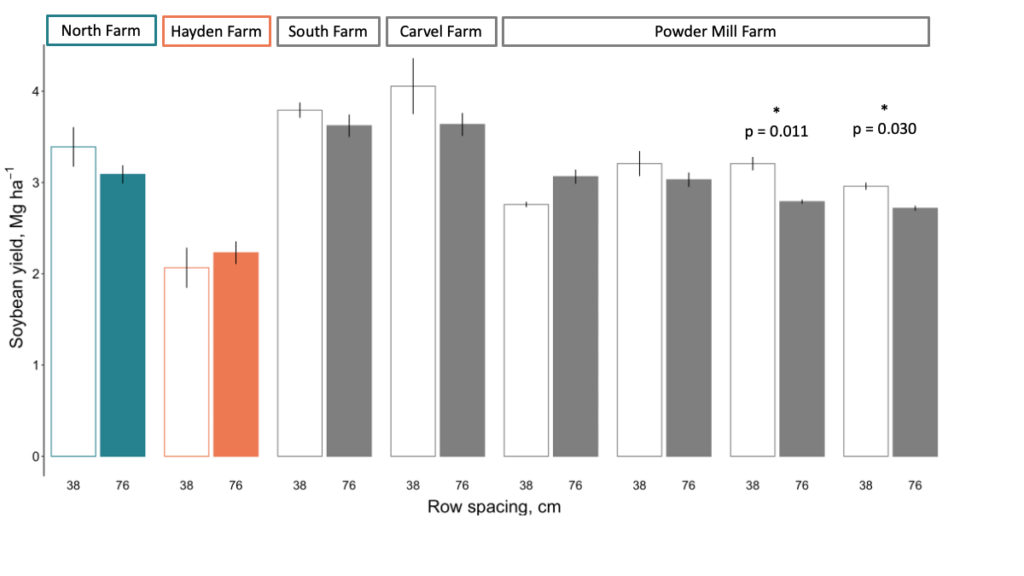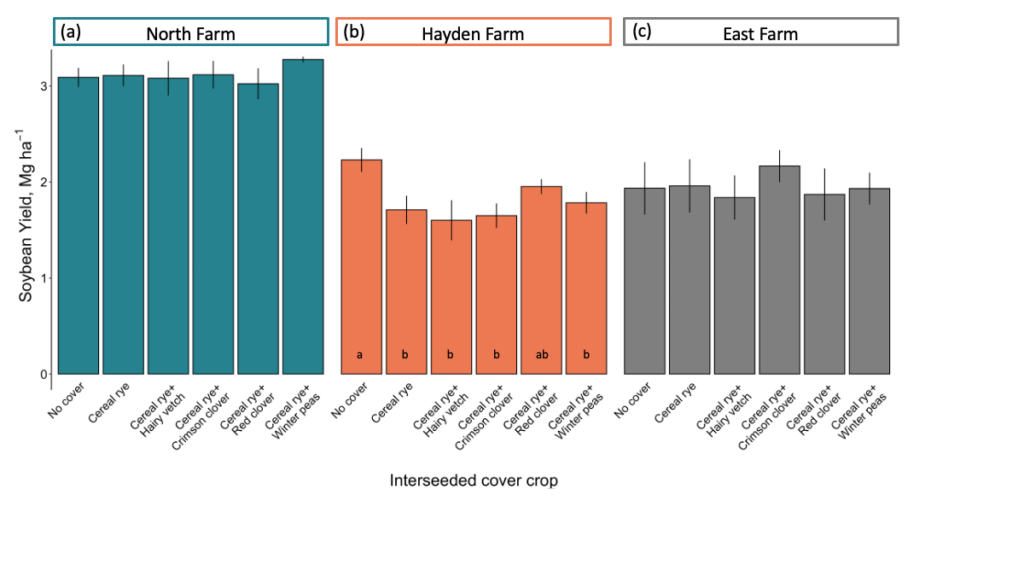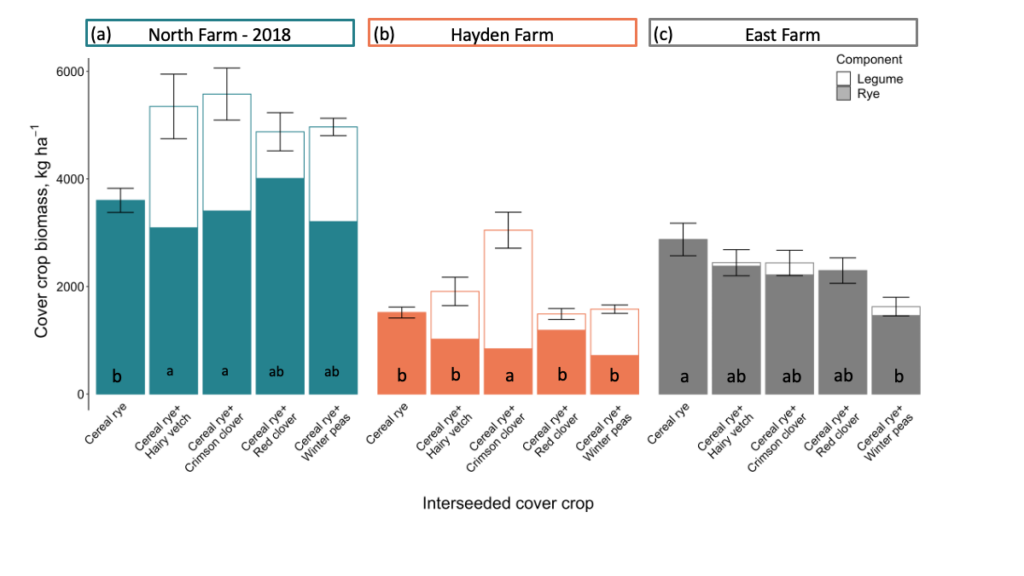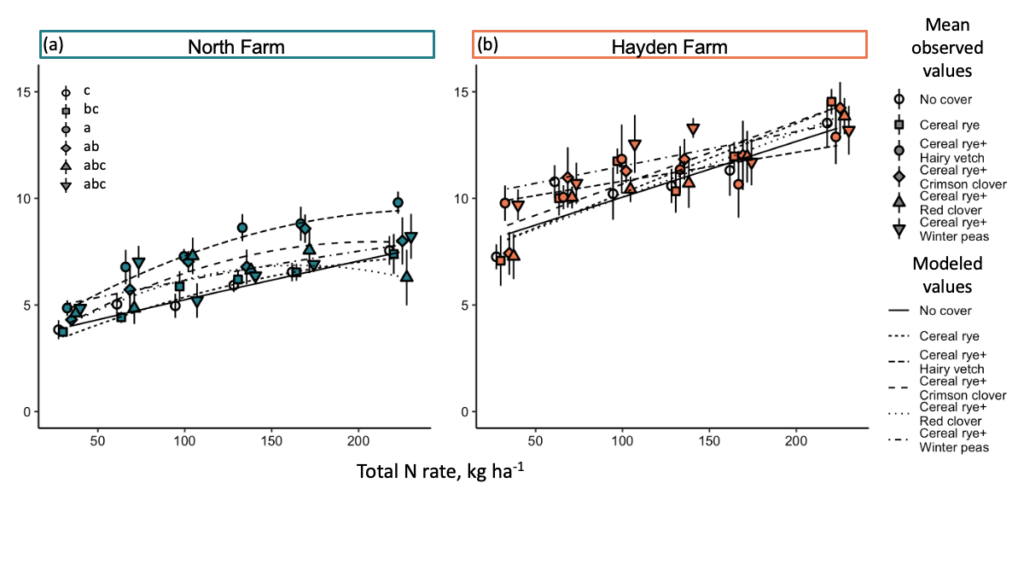Final report for GNE18-185
Project Information
Winter legume cover crops can provide organic N to the subsequent corn (Zea mays L.) crop. However, legume cover crop adoption is limited in the mid-Atlantic US by the short establishment window after double-crop soybean (Glycine max (L.) Merr.) harvest. Interseeding legume cover crops into double-crop soybean with a modified seed drill could improve on previous interseeding methods.
We conducted field trials in which mixtures of cereal rye (Secale cereale L.) + hairy vetch (Vicia villosa Roth), crimson clover (Trifolium incarnatum L.), red clover (Trifolium pratense L.), or winter pea (Pisum sativum var. arvense (L.) Poir) were interseeded into double-crop soybean on 76 cm wide row spacing. We also conducted double-crop soybean yield trials to evaluate the effect of row-spacing on yield, because the modified seed drill used for interseeding requires 76 cm wide row spacing but farmers in the mid-Atlantic US plant soybean in 19 to 38 cm rows. Overall, there was minimal to no effect of row spacing or interseeding on double-crop soybean yield. Cover crop biomass varied by species, ranging from 1–7 Mg ha-1. N levels in spring cover crop biomass at termination were higher in cereal rye + legume treatments (mean 79 N kg ha-1) than in cereal rye alone (mean 30 N kg ha-1; p < 0.001). We also examined the effect of fall-interseeded cover crop mixtures on corn yield. Corn yields were low in 2018 due to heavy rainfall, yet we observed higher corn yields in the cereal rye + hairy vetch cover crop compared to no cover crop and cereal rye alone. In 2019, corn yields were higher, but there was no cover crop treatment response.
These experiments demonstrated that legume cover crops can be viably interseeded with a modified drill into double-crop soybean in late summer as a strategy for incorporating legume cover crops into the predominant mid-Atlantic US cropping rotation. The field trials also demonstrated the specific benefits of integrating legumes into cropping rotations, namely increased N cycling efficiency and resiliency to extreme weather patterns characteristic of climate change.
The specific objectives of this research were to:
(1) Quantify the effect of row spacing (38 cm vs. 76 cm) on double-crop soybean yield. Hypothesis: there will be no significant yield difference between double-crop soybeans planted in 38 cm rows vs. 76 cm rows.
(2) Evaluate the effect of interseeded cereal rye-legume cover crop mixtures on wide-row double-crop soybean yield. Hypothesis: there will be no difference in yield between wide-row (76 cm) soybean grown with and without interseeded cover crops.
(3) Determine the legume species which, in combination with cereal rye in wide-row double-crop soybeans, produces the largest amount of cover crop biomass. Hypothesis: the cereal rye-hairy vetch cover crop treatment will produce the highest levels of biomass of the five cover crop treatments.
(4) Quantify nitrogen contribution of cover crop mixtures to corn yield. Hypothesis: corn yields will be the highest for corn planted in the cereal rye-hairy vetch treatment plots.
In the mid-Atlantic region, the inclusion of double-crop soybean in wheat-soybean-corn rotations limits legume cover crop adoption due to the shortened window for establishing cover crops after the soybean harvest. Double-crop soybeans are harvested in mid-November; however, legumes must be seeded by early October in this region to ensure establishment and high biomass production. This limitation is problematic because a cereal rye-legume cover crop mixture could provide erosion control in the fall and winter and nitrogen to the following corn crop in the spring. The purpose of this project was to evaluate a novel cover crop interseeder technology, which allows growers to drill cover crops into a standing soybean crop. This practice could transform growers’ ability to integrate legume cover crops into a grain rotation and offset inorganic nitrogen fertilizer needs in the corn phase. However, it would require transition from a narrow-row soybean spacing (19 - 38 in) to a wide-row spacing (76 cm). Specific objectives of this study included: 1) quantify the effect of row spacing (38 cm vs 76 cm) on double-crop soybean yield; 2) evaluate the effect of interseeded cover crops on wide-row double-crop soybean yield and harvestability; 3) determine the legume species which, in combination with cereal rye in wide-row double-crop soybeans, produces the largest amount of cover crop biomass; and 4) quantify nitrogen contribution of cover crop mixtures to corn yield.
Cooperators
- (Educator and Researcher)
Research
Study sites. Field experiments were conducted at the USDA- ARS Beltsville Agricultural Research Center near Beltsville, MD (BARC; 39.03 ˚N, 76.93 ˚W; North Farm, South Farm, East Farm, and Powder Mill Farm); the University of Maryland’s Central Maryland Research and Education Center near Glenn Dale, MD (39.01˚ N, 76.83 ˚W; Hayden Farm); and the University of Delaware’s Carvel Research and Education Center near Georgetown, DE (38.64 ˚N, 75.46 ˚W; Carvel Farm; Table 1). We had a total of nine site-years, two sites in 2017 (North and South Farms), three sites in 2018 (Hayden, East and Carvel Farms), and four sites in 2019 (Powder Mill Farm). Information on soil composition and bulk density for each field site is available in Table 1.
Table 1. Soil properties and study years of double-crop soybean-cover crop trials in the mid-Atlantic US.
|
Field site |
Year |
Field location |
Location coordinates |
Soil type† |
Soil organic matter (%)† |
Bulk density, g cm-3† |
|
North Farm |
2017-2018 |
BARC North Farm Beltsville, MD |
39.03˚N, 76.93˚W |
Hammonton loamy sand (coarse-loamy, siliceous, semiactive, mesic Aquic Hapludults) |
1.60 |
1.42 |
|
Hayden Farm |
2018-2019 |
Central Maryland Research and Education Center Glenn Dale, MD |
39.01˚N, 76.83 ˚W |
Downer-Hammonton complex: Downer loamy sand (coarse-loamy, siliceous, semiactive, mesic Typic Hapludults); Hammonton loamy sand (coarse-loamy, siliceaous, semiactive, mesic Aquic Hapludults); and Russett-Christiana complex: Russett sandy loam (fine-loamy, mixed, semiactive, mesic Aquic Hapludults); Christiana silt loam (fine, kaolinitic, mesic Aquic Hapludults) |
2.19 |
1.52 |
|
South Farm |
2017-2018 |
BARC South Farm Beltsville MD |
39.03˚N, 76.94˚W |
Codorus and Hatboro silt loam (fine-loamy, mixed, active, mesic Fluvaquentic Dystrudepts) |
2.12 |
1.34 |
|
East Farm |
2018-2019 |
BARC East Farm Beltsville, MD |
39.03˚N, 76.89˚W |
Russett-Christiana complex: Russett sandy loam (fine-loamy, mixed, semiactive, mesic Aquic Hapludults); Christiana silt loam (fine, kaolinitic, mesic Aquic Hapludults) |
2.9 |
1.5 |
|
Carvel Farm |
2018 |
University of Delaware Carvel Farm |
38.64˚N, 75.46 ˚W |
Pepperbox loamy sand (loamy, mixed, semiactive, mesic Aquic Arenice Paleudults) and Rosedale loamy sand (Loamy, siliceous, semiactive, mesic Arenic Hapludults) |
1.09 |
1.64 |
|
Powder Mill Farm |
2019 |
BARC East Farm Beltsville, MD |
39.03˚N, 76.90˚W |
Russett-Christiana complex: Russett sandy loam (fine-loamy, mixed, semiactive, mesic Aquic Hapludults); Christiana silt loam (fine, kaolinitic, mesic Aquic Hapludults) |
2.68 |
1.47 |
All nine field experiments were initiated in the double-crop soybean phase of a two-year rotation of winter wheat/double-crop soybean - corn. Double-crop soybean at five of the sites were interseeded with cover crop treatments (North, Hayden, South, East, and Carvel Farms). Cover crop establishment was successful at three of the interseeded sites, which were maintained through the winter (North, Hayden, and East Farms). Two sites were discontinued after soybean harvest due to insufficient measurable cover crop biomass growth (South and Carvel Farms). Of the three sites where cover crop establishment was successful, North and Hayden Farms for continuation of the experiment past cover crop termination into a second year. These two sites were planted with corn and the experiment was concluded the following fall at corn harvest. The four fields at Powder Mill Farm in 2019 were included to expand the number of site years examining the effects of soybean row spacing on yield. Therefore, these fields were not interseeded with cover crops, and the experiment concluded at double-crop soybean harvest.
Experimental design. The soybean row spacing and cover crop treatments were established in a randomized complete block design with at least four replicates in each field. Each replicate block consisted of two soybean row spacing treatments (38 and 76 cm) without cover crops (no cover crop control), along with five cover crop treatments interseeded into double-crop soybean on a 76 cm wide row spacing for a total of seven treatments. The five cover crop treatments included: (1) cereal rye alone; (2) cereal rye + hairy vetch (Vicia villosa Roth); (3) cereal rye + crimson clover (Trifolium incarnatum L.); (4) cereal rye + red clover (Trifolium pratense L.); and (5) cereal rye + winter pea (Pisum sativum var. arvense (L.) Poir). Each cover crop plot was at least 6 m wide and 61 m long.
After cover crop termination in the spring, we continued the experiment at North and Hayden Farms and planted corn into the cover crop treatment plots. In June, we divided the corn growing in the cover crop plots into six subplots of 3 m wide and 9 m long (North Farm, 2017–2018) or 18 m long (Hayden Farm, 2018–2019). These subplots received the same amount of N at planting (34 kg N ha-1), but each received a different N sidedress fertilizer rate at corn growth stage V6 (0, 34, 67, 100, 135, and 190 kg N ha -1). Placement of fertilizer subplots was randomized within each larger cover crop plot.
Field operations. Double-crop soybean was planted at 72,720 seeds ha-1 in 38 and 76 cm wide row spacing following winter wheat harvest in June or early July. Soybean seed variety and planting dates are listed in Table 2. Postemergence herbicides with no residual control were applied to eliminate weed competition without interfering with cover crop establishment. Cover crop interseeding occurred at soybean growth stage R5 (late August - early September) in most of the fields, except for at East Farm, which took place at R7 (October) due to wet field conditions (Table 3). The four fields at Powder Mill Farm that were designated for row-spacing treatment trials only, were not interseeded with cover crops. The cover crop mixtures were planted into the double-crop soybean plots at the rates described in Table 4 using an inter-seeding no-till cover crop drill (Interseeder Technologies, LLC, Woodward, PA). This planting equipment sows three rows of cover crop seeds between established 76 cm wide cash crop rows using the same technology as cash crop no-till grain drills.
Table 2. Soybean planting dates, variety information, and harvest dates at field sites where soybean yield was compared between 38 and 76 cm row spacing (Objective 1).
|
Date Soybean Planted |
Soybean variety |
Maturity group |
Date Soybean Harvested |
|
|
North Farm |
7 July 2017 |
Pioneer 93Y84 |
3.8 |
18, 20 Nov 2017 |
|
Hayden Farm |
10 July 2018 |
TA Seeds TS3959R2S |
3.9 |
23 Nov 2018 |
|
South Farm |
16 July 2017 |
Pioneer 93Y84 |
3.8 |
17 Nov 2017 |
|
Carvel Farm |
2 July 2018 |
Dynagrow S42LL63 |
4.2 |
20 Nov 2018 |
|
Powder Mill Farm |
24, 28 June 2019 |
Channel 3707R2/SR/STS |
3.7 |
5 Nov 2019 |
Table 3. Soybean and cover crop planting, harvesting and termination dates at field sites where soybean yield and cover crop biomass were analyzed by cover crop treatment were collected (Objectives 2 and 3).
|
Date Soybean Planted |
Soybean variety |
Maturity group |
Date Interseeded with Cover Crops |
Date Soybean Harvested |
Date cover crop terminated |
Cover crops Fall GDD |
Cover crop spring GDD |
|
|
North Farm |
7 July 2017 |
Pioneer 93Y84 |
3.8 |
5 Sept 2017 |
18, 20 Nov 2017 |
9 May 2018 |
950 |
537 |
|
Hayden Farm |
10 July 2018 |
TA Seeds TS3959R2S |
3.9 |
27 & 28 Aug 2018 |
23 Nov 2018 |
16 May 2019 |
1146 |
608 |
|
East Farm |
18 July 2018 |
Hubner H32-13R2 |
3.2 |
10 Oct 2018 |
13 Dec 2018 |
9 May 2019 |
310 |
589 |
Table 4. Cover crop planting species and seeding rates for a double-crop soybean interseeding experiment in the mid-Atlantic US.
|
Double-crop row spacing (cm) |
Cover crop treatment |
Seeding rates |
|
38 |
None |
N/A |
|
76 |
None |
N/A |
|
76 |
Cereal rye |
Cereal rye (126 kg ha-1) |
|
76 |
Cereal rye + hairy vetch |
Cereal rye (34 kg ha-1); hairy vetch (22 kg ha-1) |
|
76 |
Cereal rye + crimson clover |
Cereal rye (34 kg ha-1); crimson clover (22 kg ha-1) |
|
76 |
Cereal rye + red clover |
Cereal rye (34 kg ha-1); red clover (11 kg ha-1) |
|
76 |
Cereal rye + winter peas |
Cereal rye (34 kg ha-1); winter pea (78 kg ha-1) |
The following spring, the entire experimental site was treated with herbicide to terminate cover crops and control weeds.
At North and Hayden Farms, corn (‘Pioneer 0506AM’) was planted at 74,000 seeds ha-1 into the terminated cover crop plots on 26 May 2018 and 9 May 2019, respectively. At planting, 34 kg N ha-1 of starter fertilizer was applied as urea ammonium nitrate solution (30% N; UAN). The six different rates of N fertilizer (0, 34, 67, 100, 135, and 190 kg N ha -1) were applied to the corn subplots at corn stage V6 by dribbling UAN solution between corn rows on 2 July 2018 and 26 June 2019.
Data collection. Within one day of interseeding the cover crop treatments, light transmission through the soybean canopy was measured using a point sensor and light bar sensor (LI-COR BioSciences, Lincoln, NE). Soybean was harvested in November for all three years, except at East Farm in 2018, which was harvested in December due to wet field conditions. Soybean yields were collected from the whole plot with a combine and weigh wagon, except at East Farm in 2018. At East Farm, the middle two rows of the plots were collected for a length of at least 6 m with an Almaco SPC-40 Specialized Plot Combine (Almaco, Nevada, IA) with integrated weight scale to avoid driving the harvest equipment through the flooded and waterlogged sections of the field. Soybean moisture levels were measured on sub-samples of each plot harvest using a harvest moisture meter (Churchill Industries, Minneapolis, MN) and then adjusted to 13% moisture.
Just prior to cover crop termination in the spring, aboveground biomass was collected at North, Hayden and East Farm in each plot within two 0.5 m2 quadrats by cutting plants at ground level; mixtures were separated into component species. This biomass was dried at 60 °C for a minimum of seven days, weighed, and then analyzed for total C and N using dry combustion [2018 samples - LECO CN Analyzer (LECO Corporation, St. Joseph, MI); 2019 samples - Perkin Elmer 2400 Series II Elemental CHN Analyzer (PerkinElmer Corporation, Waltham, MA)].
To evaluate corn yield, the center two rows of corn from each sidedress treatment subplot were harvested with the Almaco SPC-40 specialized plot combine. Corn grain moisture was measured by the integrated combine moisture meter for each N rate plot in 2018 and as a whole plot area mean in 2019, and then grain weight was adjusted to 15.5% moisture content.
Statistical approach. In order to test the effect of row spacing on double-crop soybean yield at the individual sites, a linear mixed effects (LME) model was used with row spacing as the main effect and block as the random effect. To test the effect of cover crop interseeding and fall cover crop growth on soybean yield at North, Hayden and East Farms, an LME model was used with cover crop treatments (e.g., no cover crop, cereal rye, cereal rye + crimson clover, etc.) as the main effect and block as the random effect. Additional LME models were used to test the effect of cover crop treatment on spring cover crop biomass production and cover crop N concentration with cover crop treatment as the main effect and block as the random effect. All LME models were run using the lmer function in the nlme package in R (Bates et al., 2015; Pinheiro et al., 2020).
To analyze subsequent corn yields, we tested an ensemble of models with cover crop treatment, N rate, and their interaction as fixed effects and block as the random effect. All LME models for corn yield were run using the lme function in the nlme package in R with the maximum likelihood method (Pinheiro et al., 2020). We first assessed curves describing plateau, linear, quadratic, linear plateau, and quadratic plateau mixed effects models of corn yield response to N rate by cover crop species. Model selection was conducted using likelihood ratio tests on hierarchically nested pairs of models (e.g., adding or removing a single coefficient at a time). The following two models were fit; each coefficient was estimated for each cover crop treatment:
Linear: Y = 𝜷1·X + 𝜷0 + BBlock + 𝜺 (1)
Quadratic: Y = 𝜷2·X2 + 𝜷1·X + 𝜷0 + BBlock + 𝜺 (2)
where Y is the dependent variable [corn grain yield (Mg ha-1)] and X is the N rate (kg ha-1). P is the plateau Y value and XP is the value for X at which the linear or quadratic response meets the plateau. After selecting the model according to the likelihood ratio tests, coefficient contrasts were conducted with the emmeans (Lenth, 2019) and multcomp (Hothorn et al., 2008) packages. Goodness-of-fit for each model was reporting using an R2 analog that is derived from the likelihood ratio test (Magee, 1990; Kramer, 2005):
R2 = 1-exp(- (2/n)(logLm-logLo)) (3)
where logLM is the log-likelihood of the model of interest, logLO is log-likelihood of the intercept only model, and n is the number of observations. No transformations were necessary to improve the normality of the soybean yield, cover crop biomass, or corn yield data sets. Analyses were conducted in the R environment for Macintosh (R Core Team, 2020).
At this stage, I have finished collecting and analyzing all of the data pertaining to Project Objectives 1, 2, 3, and 4.
Objective 1: Quantify the effect of row spacing (36 cm vs 72 cm) on double-crop soybean yield.
Experimental result: No significant differences in soybean yield were detected between narrow (36 cm) and wide (72 cm) row spacing treatments (n.s.) in 6 out of 8 field sites where tested. At the two field sites in 2019 that showed lower yields in wide-row soybean than narrow-row soybean, the differences were minimal and the yields in the wide-row soybean (2.8 and 2.7 Mg ha-1; Fig. 3) were still higher than mean soybean yields across the state of Maryland from 2013-2017 (2.4 Mg ha-1; USDA NASS, 2017).
At East Farm in 2018, yields were not included in the analysis of the row-spacing effect because the double-crop soybean yield of the narrow-row spacing was not collected at that location due to crop injury.
Table 5. Double-crop soybean yield means of narrow and wide row spacing treatments (Mg ha-1) with standard error in parentheses.
|
|
|
Soybean Yield (Mg ha-1) |
|
|
|
Farm field |
Year |
Narrow (38 cm) |
Wide (76 cm) |
|
|
North Farm |
2017 |
3.4 (0.2) |
3.1 (0.1) |
ns |
|
South Farm |
2017 |
3.8 (0.1) |
3.6 (0.1) |
ns |
|
Hayden Farm |
2018 |
2.1 (0.2) |
2.2 (0.1) |
ns |
|
Carvel Farm |
2018 |
4.1 (0.3) |
3.6 (0.1) |
ns |
|
Powder Mill Farm 1 |
2019 |
3.1 (0.0) |
2.8 (0.1) |
ns |
|
Powder Mill Farm 2 |
2019 |
3.2 (0.1) |
3.0 (0.1) |
ns |
|
Powder Mill Farm 3 |
2019 |
3.2 (0.1) |
2.8 (0.0) |
p < 0.05 |
|
Powder Mill Farm 4 |
2019 |
3.0 (0.0) |
2.7 (0.0) |
p < 0.05 |
Figure 1. Double-crop soybean yields comparing narrow (36 cm) and wide (72 cm) row spacing across eight site years (2017-2019). Bars represent the standard error of the mean. Soybeans were planted and harvested in Maryland in 2017 (North and South Farm), Maryland in 2018 (Hayden Farm), Delaware in 2018 (Carvel Farm), and Maryland in 2019 (Powder Mill Farm).
Objective 2: Evaluate the effect of interseeded cereal rye- legume cover crop mixtures on wide-row double-crop soybean yield.
Experimental results:
- No significant differences were detected between double-crop soybean yields in the cover crop species treatments at North and East Farm (n.s.; Table 6).
- At Hayden Farm, the double-crop soybeans without interseeded cover crops yielded more than the treatment plots with interseeded cover crops, except for the cereal rye + red clover treatment. This competitive effect is surprising because the cover crop biomass at this site was lower than at the other field sites.
- At South and Carvel Farms, the interseeded cover crop seeds germinated but the seedlings did not survive under the soybean canopy, so double-crop soybean yields were not evaluated at these locations.
Table 6. Mean double-crop soybean yield of cover crop treatment plots (Mg ha-1) with standard error in parentheses. Values with different letters indicate significant differences in post-hoc Tukey contrasts.
|
|
Soybean yield (Mg ha-1) |
|||||
|
Field (Year) |
No cover crop |
Cereal rye |
Cereal rye + Hairy vetch |
Cereal rye + Crimson clover |
Cereal rye + Red clover |
Cereal rye + Winter pea |
|
North Farm (2017) |
3.1 (0.1) |
3.1 (0.1) |
3.1 (0.2) |
3.1 (0.1) |
3.0 (0.2) |
3.3 (0.0) |
|
Hayden Farm (2018) |
2.2 (0.1) a |
1.7 (0.1) b |
1.6 (0.2) b |
1.6 (0.1) b |
2.0 (0.1) ab |
1.8 (0.1) b |
|
East Farm (2018) |
1.9 ( 0.3) |
2.0 (0.3) |
1.8 (0.2) |
2.2 (0.2) |
1.9 (0.3) |
1.9 (0.2) |
Figure 2. Double-crop soybean yields in 76 cm wide rows across interseeded cover crop treatments where cover crops survived past emergence. Letters inside each bar represent significance of post-hoc Tukey contrasts (p < 0.05) among cover crop treatments within field site. Error bars represent the standard error of the mean. Soybeans were planted and harvested in Maryland in 2017 (North Farm) and 2018 (Hayden Farm and East Farm).
Objective 3. Determine the legume species which, in combination with cereal rye in wide-row double-crop soybeans, produces the largest amount of cover crop biomass.
Experimental results
- At North Farm, cover crop biomass was significantly greater in cereal rye + hairy vetch and cereal rye + crimson clover than cereal rye alone (p=0.02, Table 7).
- At Hayden Farm, the cereal rye + crimson clover clover treatment biomass was significantly greater than the other cover crop treatments (p < 0.001, Table 7).
- At East Farm, cereal rye monoculture biomass was significantly higher than cereal rye + winter pea, but there were no other significant differences detected among treatments (p=0.03, Table 7).
- Cover crop growth was most likely low in the 2018-2019 growing season at Hayden and East Farms due to high rainfall in the fall and winter. Furthermore, legume establishment was poor at East Farm in 2018 as interseeding was delayed until 10 October due to heavy rains in September. Nevertheless, the drill interseeded cover crops at Hayden and East Farms produced equivalent or larger amounts of spring biomass than past studies on drill interseeding or broadcasting cover crop seeds into full-season soybean
Table 7. Mean spring cover crop biomass (kg ha-1) collected immediately before termination with standard error in parentheses. Values with different letters indicate significant differences in post-hoc Tukey contrasts.
|
|
Cover crop biomass (kg ha-1) |
||||
|
Field (Year) |
Cereal rye |
Cereal rye + Hairy vetch |
Cereal rye + Crimson clover |
Cereal rye + Red clover |
Cereal rye + Winter pea |
|
North Farm (2018) |
3601 (224) b |
5348 (600) a |
5578 (484) a |
4877 (355) ab |
4967 (162) ab |
|
Hayden Farm (2019) |
1516 (101) b
|
1908 (264) b
|
3046 (335) a
|
1489 (102) b
|
1578 (79) b
|
|
East Farm (2019) |
2874 (303) a |
2442 (243) ab |
2438 (236) ab |
2296 (237) ab |
1625 (173) b |
Figure 3. Interseeded cover crop biomass by cover crop treatment. The solid bars represent the cereal rye component of the biomass, the white bars represent the legume component of the biomass, and the outer outline represents the total cover crop biomass. Letters inside each bar represent significance of post-hoc Tukey contrasts (p < 0.05) among cover crop treatments within field site. Cover crop biomass was collected in the spring of 2018 (North Farm) and spring of 2019 (Hayden Farm and East Farm).
Objective 4. Quantify nitrogen contribution of cover crop mixtures to corn yield.
Experimental Results:
- Even when the legume components of cover crop mixtures were small, the legumes contributed proportionately higher N levels than the larger cereal rye biomass. At both North Farm and Hayden Farm, the cover crop treatmnents with higher biomass (Fig. 3) also had higher N content. Even when legume cover crop biomass was low, as it was at East Farm, cover crop N content was higher in the mixtures than in the cereal rye only treatment (Fig. 4)
- In 2018, corn yields at North Farm were overall diminished by record setting precipitation and waterlogged field conditions. However, the corn in the cereal rye + hairy vetch treatment yielded higher than corn in the no cover crop and cereal rye only treatments.
- Corn yields in 2019 at Hayden Farm were more typical of the region however there were no differences detected in yield between cover crop treatments, likely due to the lower spring cover crop biomass (Fig. 2).
Table 8. Nitrogen content (kg ha-1) of interseeded cover crop treatments from Site 1. Letters next to each value indicate significance of contrasts (P<0.05) between cover crop treatments within each field site. *** indicates significance at P<0.001.
|
|
Nitrogen content (kg ha-1) |
||||
|
Field (Year) |
Cereal rye |
Cereal rye + Hairy vetch |
Cereal rye + Crimson clover |
Cereal rye + Red clover |
Cereal rye + Winter pea |
|
North Farm (2018) |
32.6 (1.3) b |
133.6 (18.3)a |
106.8 (10.9) a |
144.7 (14.9) a |
131.6 (15.3) a |
|
Hayden Farm (2019) |
23.5 (1.5) c |
40.4 (6.5) b |
55.6 (6.9) a |
25.4 (2.0) c |
36.1 (1.3) b |
|
East Farm (2019) |
35.4 (3.5) d |
60.2 (2.0) bc |
82.6 (9.1) ab |
35.8 (4.7) cd |
89.0 (14.1) a |
Figure 4. Nitrogen (N) content of cover crop biomass by cover crop treatment. The solid bars represent the cereal rye component of the biomass, the white bars represent the legume component of the biomass, and the outer outline represents the total cover crop biomass. Letters inside each bar represent significance of post-hoc Tukey contrasts (p < 0.05) among cover crop treatments within field site. Cover crop biomass was collected in the spring of 2018 (North Farm) and spring of 2019 (Hayden Farm and East Farm).
Figure 5. Corn grain yield by cover crop treatment. The corn yield was best fit with a quadratic model in 2018 (Rlrt = 0.64) and a linear model in 2019 (Rlrt = 0.36). Lines represent the modeled values for each cover crop treatment. Points represent the mean observed values at each total N rate and error bars represent the standard error of the mean.
Photos (clockwise from top left): Cereal rye + winter pea experimental plot at Site 3 in Fall 2018; cereal rye + crimson clover experimental plot at Site 3 in Fall 2018; Harvest Breakfast presentation in December 2018; interseeding cover crops into 76 cm wide soybeans at Site 5 in September 2018.
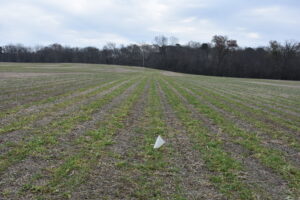

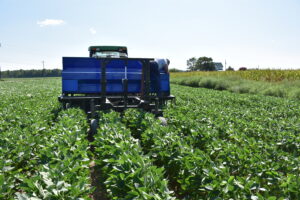

These experiments demonstrated that legume cover crops can be viably interseeded with a modified drill into double-crop soybean in late summer as a strategy for incorporating legume cover crops into the predominant mid-Atlantic US cropping rotation. The data from eight field site years suggest that widening row spacing from 38 cm to 76 cm to accommodate interseeding in the mid-Atlantic US poses minimal risk to double-crop soybean yields. Additionally, interseeding cover crops at soybean growth stage V5-V7 had little to no effect on the yield of double-crop soybean planted in 76 cm wide rows. By interseeding the cover crops into double-crop soybeans in late summer, legumes were successfully established in mixture with cereal rye, accumulating higher total spring cover crop biomass and N content than cereal rye alone. Corn yield results indicated benefits from the cereal rye + legume mixtures when total cover crop biomass reached 4-8 Mg ha-1, which mitigated crop losses from extreme weather in 2018. Climate change is expected to bring more intense and frequent rainfall in the mid-Atlantic, so it is expected that the region will experience more years with heavy rainfall patterns similar to 2018. Increasing legume cover crop adoption with this improved method of interseeding can benefit N management and climate change resilience on farms in the mid-Atlantic US.
Education & Outreach Activities and Participation Summary
Participation Summary:
On December 5th 2018, I presented my preliminary results and field trial experiences to farmers and agricultural educators at the Kent Country Harvest Breakfast in Chestertown, MD.
In September 2019, I published a newsletter article for the University of Maryland Extension Agronomy news blog.The extension article focused on presenting the initial results and experimental observations from the first rotation of the soybean row spacing and cover crop treatments.
In November 2019, I attended the annual ASA-CSSA-SSSA meeting in San Antonio, TX to present research findings during a fifteen-minute oral presentation.
Also in November 2019, I participated in the Northeast Cover Crops Council Annual Conference poster session and field day tour of the Beltsville Agricultural Research Center. During the field tour, I was able to describe the interseeding field trials and present how the InterSeeder drill planter was used in the research.
January 6-8th, 2020, I attended the Northeast Plant, Pests, and Soils Conference in Philadelphia, PA, where I presented a poster with updated analysis of the corn yield data for the fourth objective.
In November 2020, I attended the annual ASA-CSSA-SSSA meeting, which was moved to a virtual format for the week of November 9th-13th due to the corona virus pandemic. I shared a 15 minute video presentation and organized a 30 min round table discussion as permitted by the online meeting format.
An article intended for publication in a peer-reviewed research journal is currently in progress. The peer-reviewed article will present our data and findings on the following objectives: (1) the yield difference between double-crop soybean planted in 38 and 76 cm wide rows; (2) the yield difference between double-crop soybean planted in 76 cm spaced rows with and without cereal rye + legume cover crop mixtures; (3) interseeded cover crop biomass and N content prior to termination; and (4) effect on corn yield the following year.
Project Outcomes
The purpose of this project was to evaluate a novel cover crop interseeder technology which allows growers to drill cover crops into a standing soybean crop. This practice could transform growers’ ability to integrate legume cover crops into a grain rotation and offset inorganic nitrogen fertilizer needs in the corn phase. Planting cover crops in a timely manner in the fall to ensure that enough biomass is accumulated to provide the ecosystem and economic benefits of cover crops to the farm and farmer continues to be a central challenge to cover crop adoption rates in the mid-Atlantic region. By utilizing this interseeding technology, farmers stand to benefit from participation in the state cover crop subsidy program as well as decreased spending on nitrogen fertilizer for the following crop and stronger resilience of cropping systems to the extreme weather patterns of climate change.
This project has strengthened my interest in developing techniques for large-scale farming to shift towards more environmentally and economically sustainable methods. The length of each experimental field trial session has allowed me to see the range of how adoption of this interseeding method would impact a full two-year crop rotation on a commercial farm. Additionally, with the opportunity to run two rounds of these two-year field trials has come the benefit of seeing how the interseeded double crop soybeans and cover crops perform in very different weather and in different locations with different soil types.
